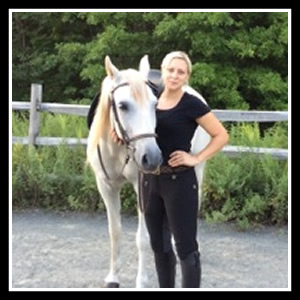Miracle Update 2

Hello this is Will Faerber from Art2Ride and today we are doing an update on the rescue horse Miracle. Miracle has been here with us for about six weeks now, and he has gone from being a nervous uptight horse to standing in the cross ties absolutely beautifully.
We started introducing the saddle to him just this week and he is coming out and stretching out into the contact quite nicely and getting over his back, just like we want him to do. If you look, his coat and whole body has improved already.
The way we work with these young horses is to take them directly out to the arena and never make them stand still in the cross ties until after working, that is why he stands so nicely in the cross ties now. Now he stands perfectly in the cross ties and is not nervous at all. Today we are going to start getting on him after he becomes nice and relaxed here in the trot.
Once again this is Will Faerber from Art2Ride with my associate trainer Amber Matusek and Miracle. See you next time!
2 responses to “Miracle Update 2”
Leave a Reply
I have watched a multitude of your videos and 1 question sticks out to me. On the lunge, how do horses learn to stretch downward and STAY down? Many will stretch willingly, but only for a moment.
When mounted, how do you ask a horse that doesn’t stretch willingly to stretch down. What are the aids to ask for this? A lot of horses will just walk around with a “neutral” head and neck even if you do have light contact so it seems as though there must be some sort of aids for the downward stretch.





I have watched a multitude of your videos and 1 question sticks out to me. On the lunge, how do horses learn to stretch downward and STAY down? Many will stretch willingly, but only for a moment.
When mounted, how do you ask a horse that doesn’t stretch willingly to stretch down. What are the aids to ask for this? A lot of horses will just walk around with a “neutral” head and neck even if you do have light contact so it seems as though there must be some sort of aids for the downward stretch.
Answered by Art2Ride Associate Trainers:
Amber Matusek I always teach the horse to stretch consistently on the lunge line first before trying to do it under saddle. We have a few videos on that. The basic idea is to push the haunches away from you. You might have to bring the horse in on a smaller circle. I would use side reins. Also keep a steady contact with the lunge line and bring the horses nose in on the circle, so position soften. The idea to soften the horse at the jaw and poll so he will stretch down. You must keep good activity coming through from his hind legs while you are doing this. After you have a consistent stretch on the lunge you can try under saddle. Which are the same aids, steady contact, and creating a shoulder in with moving the horse away from your inside leg. Good luck! WAT@A2R
Sammy Thomas Hi there, your first question is ‘how do horses stretch and stay down?’ This simply takes time. The kind of stretch you see in the video’s starts at the hind end. When the horse steps under himself with his hind end, it activates the abdominal muscles which lifts the back and as a result the horses head and neck drops. When all these happen correctly together, it causes the horse’s brain to release endorphines, giving that feel good feeling. Together with rewarding the horse for his efforts he learns to stretch for longer and longer as he gets stronger he will become more consistant in the stretch. The best way to begin teaching this is through work in hand because we are closer to the horse, we are able to ask the horse to step under more effectively and actively which starts the chain reaction of the stretch, then we move onto lunging. When the horse hollows we bring them closer to us on to a smaller circle whilst asking the horse to step under himself actively, once the horse offers the stretch we release him onto a slightly bigger circle which serves as a reward for their good efforts. By the time we get to riding our horses, they have already learnt how to stretch through work in hand and lunging and the horse will have already developed a level of consistancy. When we are riding our horses, we try to use the same signals we already taught them when working them in hand so we use our legs and dressage whip to create activity and ask the horse to step under with his hind legs and with our hands we keep a consistant light contact, allowing the rains to slip through our fingers to enable the horse to stretch down with his head and neck but making sure the contact stays the same. Lateral work for example the leg yield and shoulder fore are very effective ways to encourage the horse to step under himself both in hand and under saddle. Hope that helps.